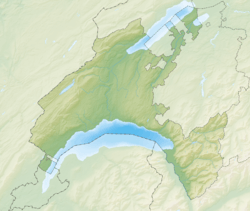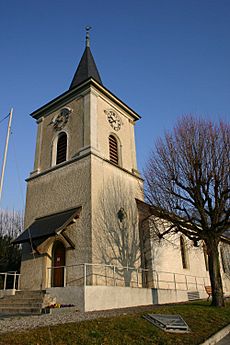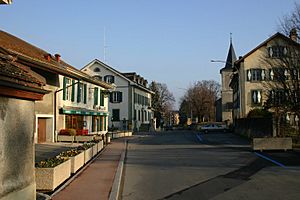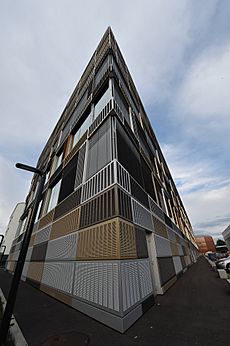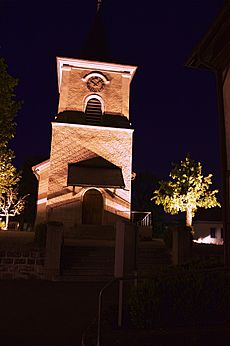Écublens, Vaud facts for kids
Quick facts for kids
Écublens
|
||
|---|---|---|
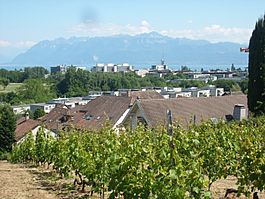
Écublens
|
||
|
||
| Country | Switzerland | |
| Canton | Vaud | |
| District | Ouest Lausannois | |
| Area | ||
| • Total | 5.72 km2 (2.21 sq mi) | |
| Elevation | 428 m (1,404 ft) | |
| Population
(Dec 2020 )
|
||
| • Total | 13,157 | |
| • Density | 2,300.2/km2 (5,957/sq mi) | |
| Postal code |
1024
|
|
| Surrounded by | Bussigny-près-Lausanne, Chavannes-près-Renens, Crissier, Denges, Échandens, Lausanne, Renens, Saint-Sulpice | |
Écublens is a town in Switzerland. It's located in the Vaud area, specifically in the Ouest Lausannois. This town is a suburb of Lausanne, a larger city. You can easily get around Écublens using the Lausanne metro line 1 and various bus routes. The closest train station is in Renens.
Contents
- A Look Back in Time: History of Écublens
- Exploring the Land: Geography
- Town Symbol: Coat of Arms
- Who Lives Here: Demographics
- Important Buildings: Heritage Sites
- How Écublens is Run: Politics
- How People Work: Economy
- Beliefs and Faith: Religion
- Learning and Schools: Education
- Well-Known People from Écublens
- See also
A Look Back in Time: History of Écublens
Écublens has a very long history! People have lived here for thousands of years.
Ancient Discoveries
Archaeologists have found ancient graves in the area. A grave from the Hallstatt culture (an early Iron Age period) was found in Dorigny. Three graves from the Bronze Age were discovered in Valeyre. Even more graves from the La Tène culture (a later Iron Age period) were found in Bassenges and Valeyre.
There's also a special hill called a motte at a place known as Chateau-de-la-Motte. A motte is a raised earth mound that was often used for defense. We don't know exactly how old this motte is, or if it's connected to nearby Roman era findings.
Early Mentions and Church History
Écublens was first written about around 958-959. It was called in villa Escublens. In 964, it was mentioned as Scubilingis in a document about the Lausanne cathedral. This document said Scubilingis was near Renens.
In the 10th century, Écublens was part of the Renens area. Later, when the Bernese ruled, it was part of the Lausanne bailiwick (an area controlled by a local official).
A chapel was built in Écublens in 1156. It was connected to the Priory of Saint-Sulpice. The main church, St. Peter's, was first mentioned in 1228. By 1453, it was also under the authority of the Saint-Sulpice church.
Famous Visitors and Changes
On May 9, 1476, Charles the Bold, a powerful duke, gathered his army in Écublens. This was after his defeat at the Battle of Grandson, and he was getting ready for the Battle of Morat.
From 1536 to 1798, the area was under Bernese rule. Then, French troops arrived. On May 12, 1800, Napoleon himself inspected his troops in Écublens! He was on his way to the Great St Bernard Pass for his Italian campaign.
After the Protestant Reformation, Écublens became its own church area, or parish. This parish included Saint-Sulpice and Chavannes until 1966.
In 1803, Écublens became the capital of its district. In 1909, a local council took over from the General Council.
World War II and Growth
During World War II, a small airport was used in Écublens. After the war, there were plans to make it a bigger regional airport for Lausanne. This would have replaced the nearby Blécherett Aerodrome. However, these plans never happened, and the Écublens airport stopped being used. There was another attempt in the 1950s to build a larger airport, but that plan was also put aside.
In the 1960s, Écublens saw a lot of growth. Many people moved here, and several large companies opened branches. These included Socsil AG (1959), Socorex Isba AG (1962), Nokia-Maillefer Sapal AG (1964), ARL AG (1970), Leduc-Thévenaz Sirec AG (1972), and the administration of Migros Vaud (1979).
The University of Lausanne built its Cantonal and University Library here in 1970. Then, in 1977, the École Polytechnique Fédérale de Lausanne (EPFL) also moved to Écublens. These two universities now take up a large part of the town's area.
Exploring the Land: Geography
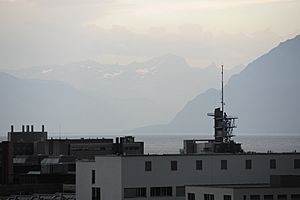
Écublens covers an area of about 5.7 square kilometers (2.2 square miles). A good portion of this land, about 27.3%, is used for farming. Forests cover about 11.6% of the area. Most of the land, about 59.5%, is developed with buildings and roads. A small part (0.7%) is rivers or lakes, and 0.5% is unproductive land.
The town was part of the Morges District until 2006. Now, it's part of the new Ouest Lausannois district.
Écublens includes several smaller areas. Le Motty is the main village, where the administration and church are located. Renges is a rural village, and there are also small hamlets like Bassenges, Villars, Epenex, and Dorigny.
Écublens sits on a moraine, which is a hill formed by glaciers. Three rivers flow through the town: the Venoge, Sorge, and Chamberonne. As mentioned, the campuses of the University of Lausanne (since 1970) and the École Polytechnique Fédérale de Lausanne (since 1978) are both in Écublens.
Town Symbol: Coat of Arms
The official symbol, or blazon, of Écublens's coat of arms is described as: Per pale Azure and Gules, a bend Or overall. This means it has a shield split vertically into blue (Azure) and red (Gules), with a golden (Or) diagonal stripe (bend) going across it.
Who Lives Here: Demographics
Écublens has a population of about 10,000 people. In 2008, about 43.3% of the people living here were foreign nationals. Over ten years (1999–2009), the population grew by about 13.1%. This growth was mainly due to people moving in and new births.
Most people in Écublens speak French (about 76.5%). Italian is the second most common language (6.5%), followed by German (4.6%).
In 2000, about 16.8% of the people were born in Écublens. Another 28.5% were born in the same canton (Vaud). About 15.9% were born elsewhere in Switzerland, and 36.0% were born outside of Switzerland.
The chart below shows how the population of Écublens has changed over time:

Important Buildings: Heritage Sites
Several places in Écublens are considered very important to Switzerland's history and culture. These are called heritage sites of national significance. They include:
- The Archives of Modern Construction at the École Polytechnique Fédérale de Lausanne (EPFL).
- The Cantonal and University Library of Lausanne and the University of Lausanne manuscripts department.
- The Jean Monnet Foundation for Europe.
How Écublens is Run: Politics
In the 2007 federal election, the most popular political party in Écublens was the SVP. They received about 24.95% of the votes. The next most popular parties were the SP (24.61%), the Green Party (14.18%), and the FDP (11.25%). About 40.4% of eligible voters participated in this election.
How People Work: Economy
Écublens has a strong economy. In 2010, the unemployment rate was 5%.
Types of Jobs
- Primary sector: This involves jobs that get raw materials from nature, like farming. In 2008, about 22 people worked in this sector.
- Secondary sector: These jobs involve making things, like in factories or construction. About 2,734 people worked in this sector, with many in manufacturing (making products) and construction (building things).
- Tertiary sector: These jobs provide services to people. This is the largest sector in Écublens, with about 9,226 people working here. Examples include sales, transportation, hotels, restaurants, finance, education, and healthcare.
In 2008, there were over 10,000 full-time jobs in Écublens. Many of these were in education, especially because of the universities.
Commuting and Transportation
Écublens is a place where many people come to work. In 2000, about 5,896 workers traveled into the town for their jobs, while 4,007 residents traveled out to work elsewhere. This means more people come into Écublens for work than leave it.
About 23% of workers used public transportation to get to work, and 57.9% used a private car.
The École Polytechnique Fédérale de Lausanne (EPFL) and its Swiss Tech Convention Center are important centers for jobs and events in Écublens.
Beliefs and Faith: Religion
Based on a 2000 survey, here's a look at the religious groups in Écublens:
- About 42.1% of people were Roman Catholic.
- About 28.8% belonged to the Swiss Reformed Church (a Protestant church).
- Smaller groups included Orthodox Christians (2.78%), other Christian churches (4.19%), and Islamic people (5.32%).
- A small number of people were Buddhist or Hindu.
- About 12.94% of the population said they didn't belong to any church, or were agnostic or atheist.
Learning and Schools: Education
Écublens has a well-educated population. About 35.2% of people have finished upper secondary education (like high school). About 12.7% have gone on to higher education, such as university.
School System
In the 2009/2010 school year, Écublens had over 1,200 students.
- Pre-school: The local government provides two years of optional pre-school.
- Primary school: Students attend primary school for four years. There were 625 students in primary school in Écublens.
- Lower secondary school: This program lasts for six years. There were 548 students in these schools.
Many students also travel to Écublens for school from other towns. In 2000, about 1,901 students came to Écublens for school, while 762 residents went to schools outside the town.
Well-Known People from Écublens
Some famous people connected to Écublens include:
- Treytorrens de Loys, who was a military commander during the First World War.
- François De Loys.
- During his time living in Switzerland, Lenin, a famous Russian revolutionary, stayed in Écublens a few times.
See also
 In Spanish: Écublens (Vaud) para niños
In Spanish: Écublens (Vaud) para niños
- Dorigny




